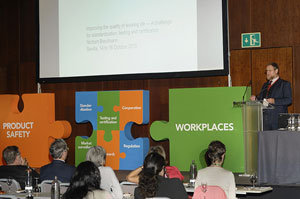KANBrief 4/15

EUROSHNET and INSHT, Spain's OSH institute, issued an invitation to come to Seville – and numerous guests from throughout Europe followed the invitation. At the 5th European Conference on Standardization, Testing and Certification in the Field of Occupational Safety and Health, 150 delegates met from 14 to 16 October 2015 to discuss how the quality of working life could be improved, and what challenges the occupational safety and health community will face in the coming years.
The aim of the EUROSHNET conferences is to promote contact between OSH experts and decision-makers in Europe, and to generate impetus for prevention work. The conference programme, with its explicitly interactive character, offered delegates from state ministries and OSH institutions, employers' and employees' bodies, the European Commission and the corporate sector a wealth of opportunity for discussion at personal level. This interaction, coupled with a social programme with a Spanish flair, lent a special touch to the conference.
In her opening speech, Dolores Limón, Director of the INSHT, expressed the clear view that a high quality of working life is dependent upon numerous influencing factors. Besides the purely technical dimension, she said, entrepreneurial and social aspects were increasingly relevant: 'We cannot address today's challenges with yesterday's solutions.'
In Café Well-being, small groups of delegates gathered and discussed ideas regarding globalization, changes in the world of work, and the compatibility of productivity and the quality of work. The discussions revealed that the factors crucial to the quality of working life are by no means uniform, and that their relative importance can also change over the course of a working life. Globalization, it was noted, does not only result in jobs migrating to low-wage countries; the coordination of OSH measures through global networks also presents considerable opportunities.
Setting course for new horizons
In his keynote speech, Walter Eichendorf (German Social Accident Insurance [DGUV]) noted that occupational safety and health is often considered an obstacle to progress. 'But we don't stop anyone from putting to sea and discovering new lands. We just want to make sure that the ship doesn't sink on the voyage.'
One central theme emerged from numerous papers: the world of work is changing rapidly. Kris De Meester (Federation of Enterprises in Belgium [FEB]) warned that faced with new forms of work and cooperation, the occupational safety and health community must rethink and adopt completely new approaches. In his view, a one-size-fits-all safety culture is not a realistic goal. Antti Koivula (Finnish Institute of Occupational Health [FIOH]) and Carlos Arranz (INSHT) were also clear in saying that automation, digitalization, demographic change and globalization demand new approaches, since the traditional instruments of occupational safety and health are increasingly ineffective.
Three main topics: Product safety, workplaces, instruments
New developments at the level of EU legislation and intelligent PPE were the focus of the session on product safety. Michael Thierbach (KAN) demonstrated that the challenge facing occupational safety and health lies in particular in developing standards and test specifications swiftly in order to keep pace with rapid technical progress. Stefan Ohlhauser (European Coordination of Notified Bodies for the Machinery Directive) described how suitable specifications were also still lacking for the certification of complex, networked machinery and plant.
The safety and health of workers at work was also examined: what developments are taking place in legislation, and what role can OSH management systems, competence certification and service standards play in the future?
In order to merge product safety and workplace safety, a range of instruments are required. These were considered more closely in workshops and lectures: standardization, testing and certification, market surveillance, research, legislation, cooperation. Raphaël Haeflinger (EUROGIP) and Norbert Breutmann (formerly SAB OHS, CEN Strategic Advisory Board for Occupational Health and Safety) showed that although many positive strategies are being followed, the instruments must be integrated much more closely in order to be truly effective.
A large jigsaw puzzle on the stage, serving as the leitmotif of the conference, demonstrated very effectively that occupational safety and health works only when all parts are combined and interlocked correctly.
Photographs and papers from the conference.
Sonja Miesner Michael Robert